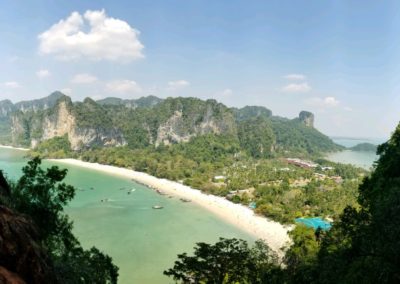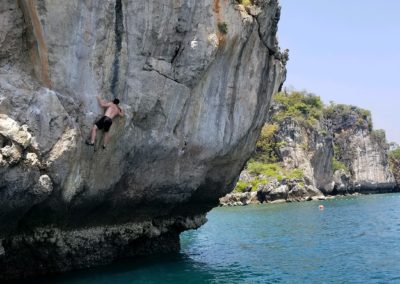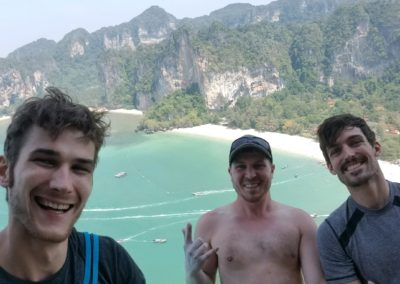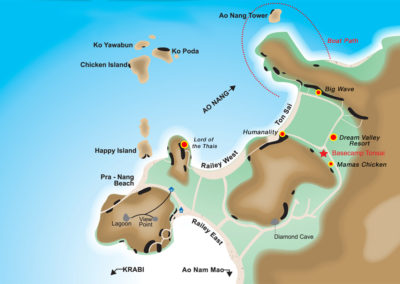Eamon and Ben take on southern Thailands steep limestone. For two weeks in February of 2018 we head out on an adventure to discover what Tonsai and Railay have to offer.
Arrival
Our flight touched down approximately 6:00 am Thai time. With the first step off of the plane Ben and I are hit with a blast of heavy humid air. We’re in southeast Asia alright. After exchanging currencies in the Krabi airport, and hailing a cab for 600 Baht, we’re off to Ao Nang where we’ll catch a long boat to our final destination, Tonsai. Our cab driver weaves in and out of traffic seemingly without regard for any rules of the road. We, however, barely notice. Within minutes we’re surrounded by limestone towers in all directions. Our hands are getting sweatier by the second, heads turning every which way to try and take it all in. This is what we’re here for and after about 32 hours of traveling, it’s a welcome sight.
We arrive at Ao Nang in one piece and wait for the tide to be high enough for us to jump aboard the first long boat we can find. Tonsai and Railay are on a peninsula and have no road access, so the only option are these long wooden viking-esk boats. Our captain soon fires up the motor and we’re on our way.
It should be noted that this is no Sunday stroll, nor is anyone going to carry your luggage without a little extra cash. Come prepared with water shoes and shorts that you can change into after your flight. You’re going to be wading out to the boats with all your bags.
The boat leaves and the warm salty air and spray form the ocean fills our senses. Waves slap against the hull of the boat and mist our faces as we watch limestone pillars come into view around the peninsula.
After about a 20 minute ride we’re dumped off on Tonsai Beach where we will be staying for the next two weeks. With a little help from a golf cart we manage to get our luggage up to the hotel where a welcoming girl managing the front desk greets us.
Because we’re only staying two weeks, we decide to stay at a place called Dream Valley Resort. It’s on the pricier end of the spectrum, but well worth the additional cost. The open-air layout is adorned with beautiful tropical gardens and dotted with duplex bungalows. The centerpiece of the resort is a two-tiered swimming pool encircled by two story hotel-style rooms, each with their own balcony overlooking the resort.
There are a number of places to stay in Tonsai, from simple shared dorms to the swanky Tonsai Bay Resort. There’s definitely something to fit your price and comfort level.
Running on airline food, adrenaline, and a need to finally touch some exotic rock, we find our room, pack up a light sport-climbing bag, and head off towards the beach. The first day we manage to sample a couple routes on the beach before the heat and rising tide force us to retreat to our hotel. But we’re here. We’ve made it. Stoke is high!!
The area and the people
Tonsai is gorgeous. There’s no other way to describe it. (pics of tonsai and railay above give an idea of the layout) Massive overhanging limestone cliffs hundreds of feet tall line the peninsula. It’s easy to get caught up just staring and taking in the foreign scenery, so very different from the cornstalks and gloomy skies back home.
Each cliff is covered in beautiful green shrubbery at the tops and diversely colored limestone melting all the way back down to the beaches below. Most of Thailand is considered tropical rainforest and it’s abundantly clear why. Coconut trees, palms, and massive vines are all thrive here. The trees and vines are perfect living quarters to harbor an array of species. We quickly became familiar with two of them. One being is a more benign monkey with whites around his eyes and the other being, a light brown species. The light brown monkeys were actually quite troublesome. They weren’t afraid of humans and weren’t afraid to go right into your climbing pack and steal our beloved cliff bars or water bottles. Bad monkey!
The people who lived and worked on the peninsula were are all very welcoming. The locals rely mostly on tourism for their livelihoods. That being said, we were still guests in their world, so we did our best to be respectful. One of the things we had to get used to was taking off your our shoes when entering a place of business or home. This isn’t true of every establishment, but it’s a good rule of thumb. Thai people believe the head to be the most revered part of the body. To them the spirit lives there. The feet being the farthest away from the head, are the least spiritual and therefore, the dirtiest. Since you can’t take off your feet, the shoes must go. It took a little getting used to, but after a couple days it became second nature. Being a tourist mecca, English was spoken fairly well. We did however pick up a few bits of Thai. “Khab kuhn cab” is the most frequently uttered phrase, meaning meaning thank you, and is said pretty much before and after any exchange.
The food
The food there was incredible, to say the least. Ben and I were very ready to eat our way through everything they had to offer. There wasn’t any easy grocery access, so we ate out about every meal. Which wasn’t a real issue for us. The meals ranged from 80 baht ( 2.60 usd) to 300 baht (10 usd.) Most were around 150 baht. The food was delicious, but at one point it did however try to kill us. Tonsai, being a remote peninsula, has sub par utilities. So both of us managed to catch the Tonsai tummy at some point during the our two week stay. From talking to other climbers staying in the area, it seemed to be an inevitability. After the tummy, it was game on. Everything from pad thai and green curries to noodle soups. And it was all very very good.
The climbing
Finally to the good stuff. Southern Thailand has abundant limestone. Railay and Tonsai have an amazing concentration of it. There are routes for all abilities with the highest concentration being in the 5.10 low 5.11 range or on the French scale, how it’s graded on the peninsula, 6a to 6c+. They ranged from 40 ft single pitches to 400 ft multi pitch. I’d say 95% of which were bolted sport routes. Every day we’d gear up, walk out of our room, and have no more than a 40 minute walk to the crag. It was great. A couple of our favorite routes were humanality. Which was a 6 pitch 5.10b. We hopped on it at about 6:00 am and finished around 10:30 am. It was 350 ft of just super fun jump hauling. It all flowed very well and about half way up you’re rewarded with a fantastic move. You move your way up the wall until you come to an undercling and a blank section. At most of the climbs back home it would have ended here, but instead, you turn around and directly behind you is a stalagtite the size of a tree trunk. You had to stem back and completely leave the limestone face which you had been scurrying up for the last 250 ft. It was wildly exposed and an unforgettable move. A lot of the climbing there had similar movement. With the stalagtites and the uniqueness of the limestone, the climbing was very three dimensional. It made for some wild movement. Definitely a lot different from the horizontal ledges and crimps back home.
All in all Thailand was an incredible trip. It was the perfect balance of climbing, adventure, and relaxation. And if you’ve ever thought about going and have any questions, feel free to grab me any time. Thanks guys. Climb on 🤙







